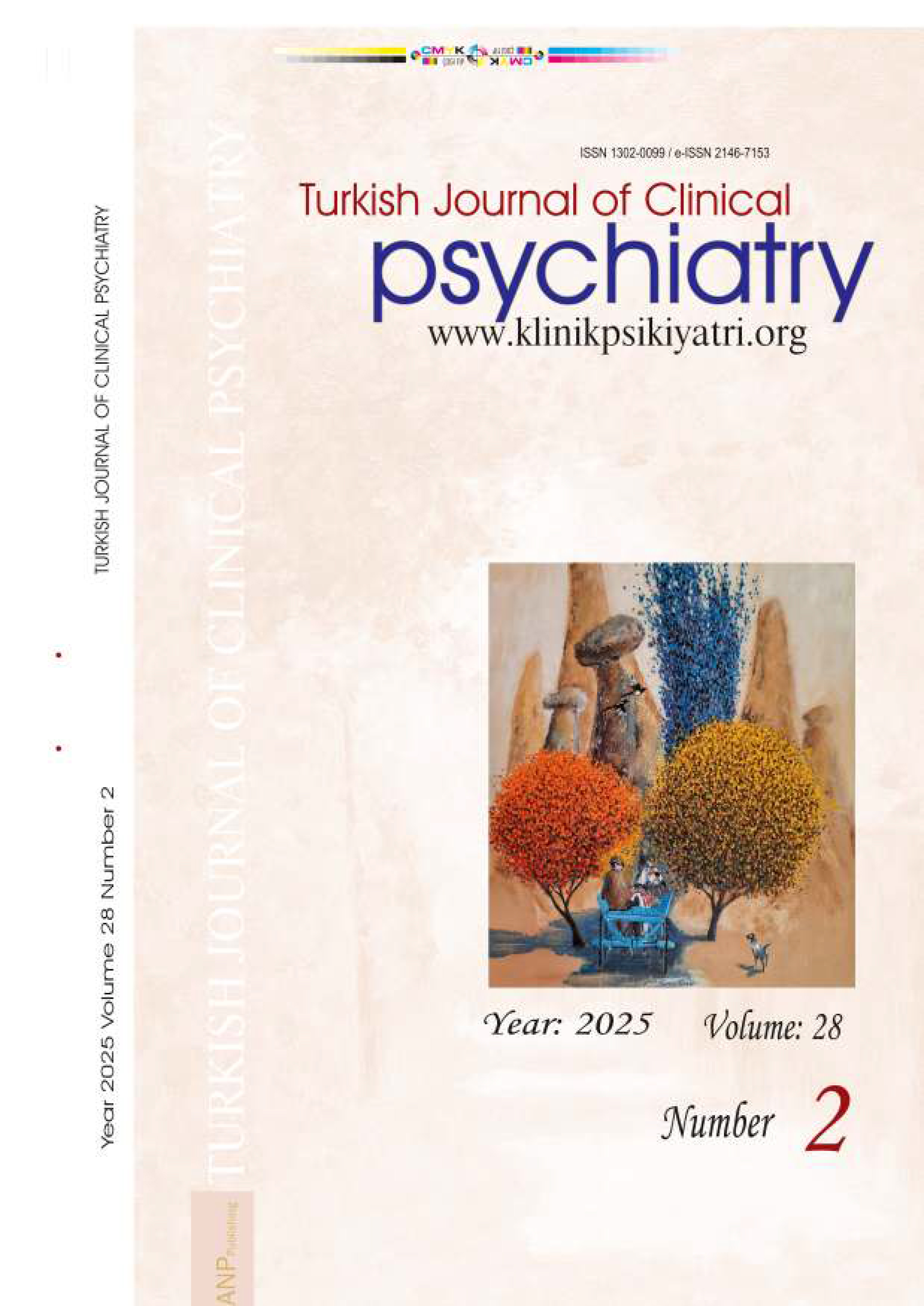





Volume: 16 Issue: 4 - 2013
| RESEARCH ARTICLE | |
| 1. | The Factors of Affecting Psychiatric Consequences of Sexual Abuse in Children and Adolescents Yasemin Yulaf, Funda Özer Gümüştaş Pages 197 - 205 Objectives: The aim of this study was to investigate the effects of child himself, his/her family and abuse related variables on psychiatric disorders that can occur following sexual abuse in children and adolescents who were referred for forensic examination to child and adolescent psychiatry outpatient clinic. Method: File informations of 77 cases of sexual abuse who referred to Tekirdağ State Hospital, child psychiatry clinic between January 2011 and September 2013 were reviewed retrospectively. Sociodemographic characteristics, mental disorders and abuse-related variables were determined. Results: It was found that there was a significant relationship between presence of Axis 1 psychiatric diagnosis and the victim's age, parents' level of education, type of sexual abuse and perpetrator-victim closeness. As a result of regression analysis which examining the effect of all of these variables on psychiatric diagnosis, other variables except for father's education level has lost its significance. Conclusion: Our study supports that sexual abuse is a risk factor alone for the precence of psychiatric diagnosis independent from the effects of all other factors. Child sexual abuse is one of the most preventable causes of mental illness and behavioral disorders. Increasing the knowledge of children and adolescents and their parents will help to reduce the incidence of sexual abuse throughout the community. |
| 2. | Rehospitalization Rates of Patients with Schizophrenia Discharged on Typical, Atypical Antipsychotics. Electroconvulsive Therapy or Combination Treatment During Six Months Bülent Kadri Gültekin, Jülide Güler, Sermin Kesebir Pages 206 - 213 Objectives: In this study, it was aimed to investigate the influence of antipsychotic drug use (typical/atypical or both, together with long acting or depot form and ECT or not) on re-hospitalizations in schizophrenic patients. Method: For this purpose, 292 schizophrenic patients who had been hospitalized in Erenköy Training and Research Hospital for Psychiatric and Neurological Diseases between April 1th 2011 and September 30th 2011 and discharged thereafter were included in the study. Drugs of the patients on discharge were recorded. Whether the patients were re-hospitalized within 6 months after discharge was learned through interviews with the patients or their relatives. These data were verified using medical records. Duration of re-hospitaliza- tion was evaluated using Kaplan-Meier survival analysis. Results: No difference was found between the patients who were re-hospitalized or not in terms of using typical, atypical or both groups of antipsychotics (p=0.175), using long acting or depot form antipsychotics (p=0.624) and applying ECT on the last hospitalization (p=0.239). Duration until re-hospitalization was not different between patients who used typical, atypical or both groups of antipsychotics together (p=0.413), long acting or depot form antipsychotics (p=0.084) and who were applied ECT or not on the last re-hospitalization (p=0.708). Conclusion: Our results indicated that treatment selection alone is not effective for prevention of rehospitalization. |
| 3. | An Overview on Psychosocial Adaptation, Depression, Anxiety and Stress Levels in Patients with Heart Disease Etem Erdal Erşan, Meral Kelleci, Berna Baysal Pages 214 - 224 Objectives: The relation between psychosocial problems and some variables in the patients with various heart disease was examined in this study. Method: This study was held Cardiology Unit of University Research Hospital in Sivas. The study was realized on 150 hospitalized patients who accepted to participate in the study. In the collection of data, socio demographic data form, Psychosocial Adjustment to Illness Scale-Self-Report and Depression Anxiety Stress Scale were used. The data were statistically evaluated with SPSS 14.0 software, Results: In our study, in terms of family environment of psychosocial adaptation scale, compared to males, females, and compared to professionals those housewives and compared to those persons with insufficient income, those with good economic status and In terms of sexual relations, those unemployed compared to the employed ones, and in terms of great familial relations, those having insufficient economic status compared to those good economic status had insufficient psychosocial adaptation (p<0.05). Total depression scales were detected to be higher in those persons who are widow, and those unemployed, as well as those living alone (p<0.05). Total depression and anxiety scores were detected to be higher in females, those with insufficient economic income and housewives (p<0.05). Total anxiety and stress scores were detected to be higher in illiterates (p<0.05). Conclusion: In this study we found out that psychosocial adaptation was deteriorated, and depression, anxiety as well as stress were enhanced. To remediate this table studies on psychosocial perspective is important. |
| 4. | Frequency and Predictors of Recurrent Hospitalizations of Schizophrenic Patients Bülent Kadri Gültekin, Jülide Güler, Sermin Kesebir, Abdülhalik Gülücü, Mine Ergelen Pages 225 - 231 Objectives: In this study, it was aimed to investigate the frequency of re-hospitalizations within 6 months after discharge and sociodemographic and clinical variables affecting it in schizophrenic patients who were treated at the hospital. Method: For this purpose, 292 schizophrenic patients who were hospitalized, treated at our hospital and discharged from the hospital between April 10th 2011 and September 30th 2011 were included in the study. Sociodemographic and clinical data (positive and negative syndrome scale: PANSS) were obtained from medical records. Results: Fifty (17.1%) of 292 patients were re-hospitalized within 6 months after discharge. None of the patients who had been hospitalized for the first time were re-hospitalized during this period. Mean duration of re-hospitalization is 85.6±52.1 days. While re-hospitalization risk was 2.3 fold greater among the patients who had the family history of psychosis, it was seen to decrease as the age of onset got smaller, increase as the number of hospitalizations and PANSS scores on hospitalization and discharge increased. Conclusion: Family history of psychosis, age of onset of the disease, number of previous hospitalizations and disease severity are the factors which affect re-hospitalization in follow up of schizophrenic patients who are hospitalized. |
| REVIEW | |
| 5. | Dopamine Receptor Supersensitivity, Supersensitivity Psychosis and Therapeutic Failure of Antipsychotic Treatment Vesile Altınyazar, Nevzat Yüksel Pages 232 - 243 One of the major problems in the treatment of schizophrenia is relapse, the reasons for which are not always clear. One of the possibilities is adaptation of the brain to long-term antipsychotic treatment, and the development of tolerance and withdrawal symptoms and subsequent observation of the loss of therapeutic efficacy of antipsychotics. Among the neurobiological causes of this condition, known as supersensitivity psychosis, are up- regulation of post-synaptic dopaminergic receptors, a progressive hypersensitivity to dopamine, and post- synaptic neuroadaptive changes in gene expression. Dopamine supersensitivity is observed as abnormal involuntary movements, increased sensitivity to minor life events and ongoing residual symptoms in clinical cases. In daily practice, supersensitivity psychosis is often interpreted as an exacerbation of the disorder, and is treated with increasing doses of AP. However, this only provides a short-term, temporary benefit. Keeping antipsychotic maintenance treatment at the lowest possible dose is thought to be protective against the development of supersensitivity psychosis. Among therapeutic approaches in patients who develop supersensitivity psychosis, switching to an antipsychotic drug with a different mechanism of action and a lower affinity for the D2 receptor, adding 2-adrenoceptor blocking drugs to the treatment, or treatment with antiepileptic drugs (valproic acid, lamotrigine, topiramate) were found to be of benefit. |
| CASE REPORT | |
| 6. | Narcolepsy Cases with Different Clinical Symptoms Pınar Güzel Özdemir, Adem Aydın, Yavuz Selvi Pages 244 - 248 Narcolepsy is an uncommon disorder and it is an underrecognized and underdiagnosed condition. It is characterized by excessive daytime sleepiness, cataplexy, sleep paralysis, hypnagogic, and hypnopompic hallucinations. Excessive daytime sleepiness is the most important symptom and misdiagnoses other mental disorders. There are different groups of patients, those having narcolepsy with cataplexy and those having narcolepsy without cataplexy that can be primary or secondary due to medical condition. Narcolepsy is considered to be caused by a complex interaction of genetic and environmental factors. The diagnosis of narcolepsy is based primarily on clinical picture. On the other hand, recent years important developments occur in the sleep disorders medicine for narcolepsy. Stimulants, modafinil and antidepressants are the pharmacological agents used in narcolepsy for treatment. Different clinical symptoms of narcolepsy may overlap with other mental illnesses. In this article, we introduced two case reports. Our first case was clinically resembling epilepsy and it was non - responsive to antiepileptic treatment. The patient was diagnosed as narcolepsy after detailed investigations than treated successfully. And second one was manifested itself by depressive symptoms, depersonalization and derealization and non-responsive to antidepressant treatment. He was subjected to further investigation tests and he was treated with stimulants perfectly after the diagnosis of narcolepsy. The awareness of narcolepsy is important so that these cases could be identified timely and appropriately managed. Thus, clinicians should be careful about the different clinical characteristics of narcolepsy. |
| 7. | Klüver-Bucy Syndrome Induced by Herpes Encephalitis: A Case Report Dursun Hakan Delibaş, Almila Erol, Levent Mete, Uğur Demir Pages 249 - 253 Herpes encephalitis is the most common sporadic, severe, focal encephalitis. It causes necrotizing lesions on inferomedial sides of frontal lobes. Unless treated, mortality rate due to Herpes encephalitis may reach up to 40-70%. The ones who survive often experience sequeles such as amnesia, aphasia, dementia, or Kluver- Bucy syndrome. To diagnose Kluver-Bucy syndrome, at least three of the following criteria are required: visual agnosia, reduced vocal or motor response, hypermete- morphosis, hyperorality, hypersexuality. In addition, aphasia, dementia, amnesia and epileptic seisures may seldom accompany the syndrome but these cases are very rare in clinical practice. In this paper we aimed to present a case who had Kluver-Bucy syndrome following an Herpes encephalitis. 31 years old, female presented with fever and headache followed by generalised tonic clonic seisures. She was diagnosed as Herpes encephalitis. She was brought to the outpatient unit of department of psychiatry afterwards. At the time of her admission, she was quiete without any reactions towards anything, she had amnesia, negativism, hyperorality, and perseverations. Her norological examination revealed aphraxia, and agnosia. Mental state examination revealed disturbed time, place, and person identification. Anxious affect was observed. She had poor thought content, her associations were disorganised, and she had perseverations. She had both short term and long term memory deficits. Her abstract thinking abilities and judgement were disturbed. Psychometric tests pointed out to deficits on attention, concentration, planning, short term memory, visual memory, and learning abilities.This patient was diagnosed as Kluver-Bucy Syndrome. |










